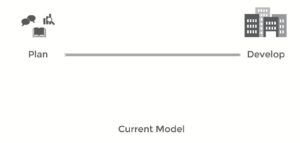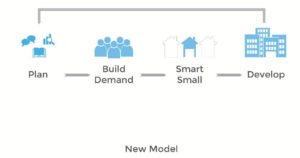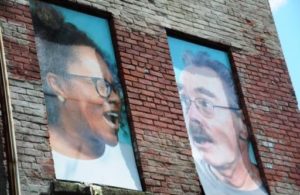When you chat with your grandmother about urban revitalization, the words that you use and the images she has in her head are likely focused on brick, stone, or clapboard buildings; on tree-lined, brick-paved streets; or on walkable main streets teeming with local retailers, hung shingles, and small offices or apartments above.
It is all about saving places. And we do it for a host of good reasons, be they economic, emotional, or to take advantage of a particular underserved market that wants to move in, not out to the hinterland exurbs.
The strategies we have relied upon mirror those images and words that we use. We focus, and understandably so, on the buildings, streets, and public spaces that make up the neighborhoods we want to save. We wrap policies around these places like bubble wrap, hoping to stem the dis- or mal-investment that has plagued them for a half century.
Design codes and zoning overlays institutionalize the wisdom of previous eras that we seem to be losing, the intuition that allowed us to build great places for millennia. To bridge the gap between what a landowner can invest in a building and what she can reasonably expect in return through rents, we have created a competitive set of tax credits that can be swapped for cash to pour into repointing the brick, popping in new windows, restoring the tin ceiling, and patching the roof.
When successful, we do save the place. Blood, sweat, tears and years go into stabilizing and restoring the bricks and mortar. Retailers open up shop, people move back in, and selfies are taken with your restored neighborhood serving as the memorable backdrop.
But saving that street or adopting that overlay district does not automatically save the neighborhood and, even if it does, it does not necessarily jump the tracks to the next neighborhood even if it exhibits some of the same great buildings and streets that dot your newly revitalized district. The movement does not scale on its own. What is more, even as we have restored investment in the place, real and often valid concerns about how we are restoring investment in the people that for generations stuck it out in the that place grow.
Enter gentrification and displacement.
And when we ignore the movement’s ability to scale and resist the difficult conversations about racial, cultural, and economic inclusion, we expose the preservation movement’s broad side to criticisms about Disneyification and loss of authenticity while isolating the pursuit of revitalization to a narrowing class of advocates that have the resources to navigate the bureaucracy, planning, lending, and trade skills necessary to bring a place back from the brink. This threatens to slow and narrow the movement right when we need to accelerate and broaden it the most.
 These shortcomings are due, in large part, to how we go about revitalizing places. In other words: the supply-only approach of property acquisition, tax credits, building stabilization and restoration, and protection policies limit the risks of doing it all. And its importance cannot be underestimated. But while doing all of that hard work with our right hands, it is critical that we do something just as important with our left.
These shortcomings are due, in large part, to how we go about revitalizing places. In other words: the supply-only approach of property acquisition, tax credits, building stabilization and restoration, and protection policies limit the risks of doing it all. And its importance cannot be underestimated. But while doing all of that hard work with our right hands, it is critical that we do something just as important with our left.
That something is a strategy we’ve come to call Demand Discovery where, through targeted activation of overlooked spaces, programming, storytelling, and ongoing tweaking, we figure out where, how, who, and what to focus on while removing the market’s mental obstacles preventing it from coming to the place you are trying to save.
A central observation of demand discovery is that, over time, we have value engineered out of the building process two key steps. We are likely to still engage in some form of planning (be it in a church basement or in a boardroom) with the intended goal of sustained development and investment.
But the leap between the two is proving to be too vast. We are missing one step by which we test those planning ideas through quick, low-cost, low-risk activations of the idea. We miss another that makes permanent the early and most successful aspects of those activations through smart, small development of the amenities and other uses that virtually all plans wish to bring back to a place. This holds just as true for a coffee shop as it does for a walkable street and allows our bigger development to be more sophisticated, market-driven (ie smarter use of gap funding), and integrated into the fabric of a place.
It is not your grandma’s picture of revitalization but, in fact, more like how places grew when she was a little girl through small scale trial and error that incrementally evolves into an extraordinary place.
Taken together, the activation and the smart small steps form the basis of Demand Discovery. They provide the critical, inclusive, and more human-scaled pace of change that is missing in standard places that seem to flip overnight (even if it took decades to pull off).
 It allows us professionals and lay people to approach and embrace change together because it is happening in such a way that is both more approachable and can be course corrected if need be.
It allows us professionals and lay people to approach and embrace change together because it is happening in such a way that is both more approachable and can be course corrected if need be.
It allows us to tell a more fine-grained, textured revitalization story that will help us retain our authentic soul and enhance our ability to access the highly competitive market for tax credits, retailers, and residents.
By coupling the supply side and its demand-creating counterpart, we engage in a process of Economic Uncovery that not only scales and broadens revitalization to the scores of neighborhoods in need of such work but does so in a way that taps into the stories, culture, and identity of the people who are or want to be there.
Economic Uncovery in Action: Walnut Hills, Cincinnati, Ohio
One of the places that we have refined and leveraged the use of Economic Uncovery is in Cincinnati’s Walnut Hills. This downtown-near neighborhood was, at one time, the city’s second downtown. It is also a short bike ride from its more famed revitalization cousin, Over-the-Rhine (one of the world’s largest collections of Italianate architecture).
Here, Over-the-Rhine’s success was not coming up the hill on its own. Walnut Hills is a large, historic, majority African-American neighborhood. It had steadily become more vacant and impoverished for decades and was remaining stubbornly so despite its proximity to Over-the-Rhine, the region’s universities, downtown Cincinnati, and several primary transportation corridors.
Poverty was at thirty percent and unemployment hovering around twenty percent. Over a thousand buildings sat vacant and scores were torn down by the year. The commercial spine, McMillan Street, had become largely empty and the neighborhood’s streets had been transformed to accommodate speed-through commuting over pedestrians and bicycles.
Through this steady decline, supply-addicted thinking predominated. A redevelopment agency, the Walnut Hills Redevelopment Foundation (WHRF) was created nearly fifty years ago and, over that time dozens of plans were hatched to bring the neighborhood back. The historic district was established, a tax-increment financing district enacted and a focus on affordable housing grew.
More recently, buildings and parcels were acquired for saving, a form-based code was adopted, and even McMillan was reversed from a one way back to a two way street. And, yet, the neighborhood failed to significantly improve. Over forty years in, WHRF began to struggle and in 2010, its Board of Directors excused its staff and took over.
In 2011, a new director was hired (one of this article’s co-authors) and a new approach was adopted with a greater balance between supply and demand-driven work. While the ledger was cleaned up with one hand, the other was busy, engaged in the Demand Discovery side of the business. Events meant to celebrate the neighborhood, like the Street Food Festival and the Music Off McMillan series, helped bring attention to the commercial spine.
But as the new leadership got its feet under itself, it went beyond simply throwing events, something that most neighborhoods already do. The activation began to focus more on the spaces, buildings, and amenities that the pile of plans repeatedly described as needed while tackling head-on some of the more pervasive story and safety problems that had plagued the neighborhood.

An installation on one of the buildings fronting Five Points meant to celebrate the neighborhood’s many faces.
For example, a grown-over convergence of five alleys was cleaned up in a neighborhood cleanup event and activated the next day as a thank you party. Rather than yearly, this event was hosted monthly and evolved into the Five Points Biergarten. As the number of people and vendors grew each month, some of them started asking about how they could be a more permanent part of what was happening in the neighborhood around it. One such vendor was Fireside Pizza.
Eighteen months later, the reformed WHRF had its first revitalized historic structure (the City’s oldest fire station), its first housing unit, and its first amenity all in a building that the neighborhood wanted as a restaurant but the conventional development industry wisdom said was either too far gone to be saved or, at best, would be a doable small office.
The $400,000 Fireside Pizza was followed by the $10,000,000 Traverran Flats that brought 30 units of market-rate residential and five retail bays back to three historic structures on the block across from Five Points. Lease ups and rents exceeded the proforma. The retailers attracted to the ground floors were not sold on what the neighborhood could be but instead were more attracted to what it was today. Both projects directly link their success to the Five Points, an effort that began with a $500 budget.
Concurrent to these important projects, the neighborhood embarked on a branding and storytelling initiative with BLDG. This soul searching process documented that, while the neighborhood had once wanted the type of investment now underway, real concerns about change and who it was for were beginning to emerge. It was at this point that the strategy pivoted to diversity and inclusion as one of the primary drivers and differentiators of its work.
Ultimately, this led to abandoning the biergartens in favor of a broader program that better synced with the neighborhood’s African-American culture. It also paved the way for bold new public art, murals, and wayfinding that reflected the DNA of the place and further celebrated and broadened the neighborhood’s reach in the marketplace.
The newly exposed narrative inspired a collaboration with MORTAR to grow African-American entrepreneurship. As Traverran Flats opened, five new businesses opened up in Walnut Hills, all minority or woman-owned in a city where, despite being half African-American, only ten percent of businesses are African-American owned.
Scaling the Movement
Revitalization is about bringing back investment to a place that, in turn, should bring investment back to the people in that place while giving the region another solid choice of where they can live regardless of who they are or how much they make. A supply-only focus falls short without demand creation. The impact of this has been real in places that we are working in, like Walnut Hills where dozens of buildings are getting brought back to life, some not even architecturally significant but have proven to be part of the neighborhood’s fabric.
The retention of such structures allows the preservation of a “never perfect” essence that protects a place from Disney and authenticity claims. More importantly, over 300 units of affordable and workforce housing are being built or are in the pipeline to supplement the market rate rental units and new for-sale houses. A new $12,000,000 Scholar House is being built and the region’s first African-American-owned craft brewery is set to open as part of a $20,000,000 redevelopment of the neighborhood’s historic RKO Paramount Theater and its surrounding buildings.
Through it all, Five Points Alley (now a fully built-out park) and Fireside Pizza remain the active center around which this neighborhood is investing. The story is clear, demand is better understood, and the market has been attracted to it. Now that the momentum is accelerating, a new type of plan was adopted in early 2017, the Strategic Investment Plan. The investment plan will focus and shape our efforts around people, transportation, public space, and development over the next five years.
Our cities, particularly our older ones, are undergoing significant change. For some, this change is going too fast and, for others, too slow if at all. Our demographics and economy are placing new burdens on these cities while our resources to respond are becoming more competitive.
The supply-only model of this important work limits its effect and threatens to stall it if we do not couple it with the demand building work that can more nimbly adapt to the pace of change and new innovations or discoveries in our neighborhoods that make them relevant today.
Neighborhoods, downtowns, institutional anchors and developers are taking heed throughout the country. In addition to Cincinnati, cities like Detroit, Nashville, Pittsburgh, Erie, Dayton and other post-industrial cities are having Demand Discovery inform, shape, and attract reinvestment in its supply and people.
About the Authors:
 Joe Nickol leads urban design and development strategy efforts as a Principal for Columbus-based MKSK. His focus is on the regeneration of our towns, cities, and neighborhoods and using the lessons of those places to inform the design of new districts and towns that are inherently highly adaptable and resilient.
Joe Nickol leads urban design and development strategy efforts as a Principal for Columbus-based MKSK. His focus is on the regeneration of our towns, cities, and neighborhoods and using the lessons of those places to inform the design of new districts and towns that are inherently highly adaptable and resilient.
Joe has directed both public sector and private development projects from small targeted pop-up efforts to billion-dollar urban revitalization projects in North America and abroad.
His work and observations have been highlighted in Planning Magazine, Better! Cities and Towns, Planetizen, Sustainable Cities Collective on PBS, at the American Planning Association National Conferences, and at the Congress for New Urbanism. Joe graduated from the University of Notre Dame, earning a Bachelor’s degree in Architecture.
 Kevin Wright has been Executive Director of the Walnut Hills Redevelopment Foundation (WHRF) since 2011 where he has helped the organization develop a new brand and mission and grow from a staff of one contracted employee to five full-time employees and several interns.
Kevin Wright has been Executive Director of the Walnut Hills Redevelopment Foundation (WHRF) since 2011 where he has helped the organization develop a new brand and mission and grow from a staff of one contracted employee to five full-time employees and several interns.
Kevin has led teams in the creation and implementation of dozens of projects ranging from small creative placemaking activities to multi-million dollar real estate deals.
Kevin earned a Bachelor’s degree in journalism from Missouri State University and a Master’s in Community Planning from the University of Cincinnati with a specialization in urban real estate and neighborhood development.




